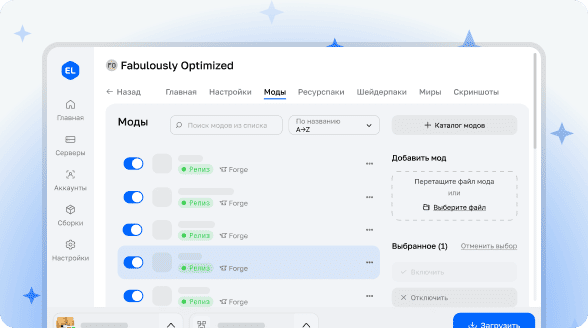

STRAYED FATES: Forsaken
Discover the traces of those who were here before you.
This project adds rare abandoned structures to the Overworld, crafted in a semi-vanilla style and inspired by pre-industrial buildings from around the world. There's no eccentric loot, no mob swarms—only the beauty of scars left by time on civilization.
STRAYED FATES: Forsaken utilizes numerous variants, complex processors, diverse decorations, and thoughtful feature usage to ensure that every structure you stumble upon becomes a unique discovery throughout your gameplay.
Content
The main theme of STRAYED FATES projects is abandoned buildings and their atmosphere, telling a story through near desolation. Each major update will be thematic and add a significant number of new structures, while minor updates may include new variants or structure sets, possible mod compatibilities, along with fixes and tweaks. The current version includes:
Homes
Structure sets: 9
- Oak: 11+(11x14) variants
- Spruce: 9 variants
- Western: 9 variants
- Snowy: 9+(9x14) variants
- Desert: 9 variants
- Bricks: 9+(9x14) variants
- Mud: 9 variants
- Oriental: 9 variants
- Turf: 9 variants
Cellar
Wells
Structure sets: 5
- Rustic: ~61732 variants
- Spruce: 15433
- Oak: 15433 variants
- Birch: 15433 variants
- Dark Oak: 15433 variants
- Cobble: 4 variants
- Mud: 4 variants
- Cobble: 9 variants
- Mud: 9 variants
- Bamboo: 5 variants
*Calculated based on the number of necessary puzzle piece variants that can be combined
Frequently Asked Questions
The term "project" refers to the datapacks/mods of STRAYED FATES, the term "update" refers to named major updates of one of the projects.
GENERAL QUESTIONS
Can this be used in vanilla and/or on a server?
All projects use the vanilla custom structure system for generation and contain no modded blocks. This can be used entirely server-side, meaning you can use it alone in singleplayer or install it on your server without other players needing to install it. Any mod support simply won't apply if you don't have the corresponding mods.
What's the difference between the datapack version and the mod version?
Content-wise—none. The only difference is that the datapack must be applied to each world separately, while the mod applies to all worlds in the instance.
Can I safely remove or install the projects in an existing world?
Yes, you'll simply stop or start finding structures only in newly generated chunks.
Is it compatible with [...]?
These projects follow the Vanilla/Fabric/Forge/Neoforge biome tag system to choose which vanilla/custom biomes allow structure spawning. This means compatibility with any worldgen datapacks or mods that correctly use these tags, as well as any other datapacks or mods. If unsure—try it and see.
Is mod [...] supported?
All supported mods of the project and their content are listed on the download pages. We do not accept requests.
Can I update safely?
You can update the projects anytime an update is available, but changes will only be visible in newly generated chunks and structures. This means fully pre-generated worlds won't see the changes.
How can I tell if it's working?
The datapack must be loaded and applied to the world, while the mod should automatically apply to all worlds in the instance. In both cases, you can use /datapack list to see if the project is there. You can also use /locate structure #project:any or /locate structure #project:update and see if you can locate the structure.
Where do I find the [...] structure?
The goal of the projects isn't to find all structures, but if for some reason you want to know where to find each one, check the corresponding file in data/project/tags/worldgen/biome/has_structure/homes/ to learn which biomes they can appear in. Ultimately, you can also use /locate structure project:update/ in-game or use jacobsjo's map website to find where each structure is located in your seed.
Will there be any backports?
No.
CONFIGURATION
There are no options directly available for the projects. To configure it, you must open the .zip or .jar (to open a .jar, rename it to .zip, then rename it back to .jar when finished) using programs like 7zip or WinRar. Note that any update may reset your changes. We do not offer support for modified versions of the project and do not permit their distribution per the license. Alternatively, you can create a datapack consisting only of the modified basic datapack code and necessary .mcmeta file that will override the desired project. This prevents breaking silence if you're making a modpack; or use Structurify.
Frequency
To change the frequency/rarity of structures, go to \data\project\worldgen\structure_set and open the desired .json. Then you can modify frequency—a value between 1 and 0 corresponding to the chances of a structure spawning when other conditions are met, spacing—the average distance in chunks between structures of that group, and separation—the minimum number of chunks between structures of that group.
Disabling
Update
To disable the spawning of update structures in your world, go to \data\project\worldgen\structure_set, find the update .json you wish to disable, then delete it or add a - at the start of its name to disable it. We also recommend deleting or disabling the corresponding function in \data\project\functions.
Set
To disable a structure group in one of the updates, open the corresponding file \data\project\worldgen\structure_set\update.json, select the module ( { } ) where the structure is labeled, along with the comma after it, then delete and save.
Piece
To disable a structure piece, go to the corresponding .json file in \data\project\worldgen\template_pool\update\, select the module ( { } ) where the structure and its weight are labeled, along with the comma after it, then delete and save.

